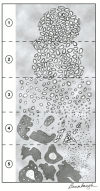Prostate cancer diagnosis
Abstract
Prostate cancer is the fourth most common malignancy diagnosed in Missouri. The diagnosis may be clinically suspected based on an elevated serum prostate specific antigen (PSA) and/or digital rectal examination abnormality. Clinical symptoms are usually a manifestation of more advanced disease. The diagnosis is typically established by histopathologic examination of needle biopsy tissue. This article reviews clinical and pathological approaches to prostate cancer diagnosis, with a focus on clinically localized disease and needle biopsy diagnosis.
Figures







Similar articles
-
[Diagnosis of prostate cancer].MMW Fortschr Med. 2010 May 13;152(19):40-2. MMW Fortschr Med. 2010. PMID: 20557001 German. No abstract available.
-
Comparison of Digital Rectal Examination and Serum Prostate Specific Antigen in the Early Detection of Prostate Cancer: Results of a Multicenter Clinical Trial of 6,630 Men.J Urol. 2017 Feb;197(2S):S200-S207. doi: 10.1016/j.juro.2016.10.073. Epub 2016 Dec 22. J Urol. 2017. PMID: 28012755 Clinical Trial.
-
The value of prostatic specific antigen density in the early diagnosis of prostate cancer.Int Urol Nephrol. 1998;30(3):305-10. doi: 10.1007/BF02550314. Int Urol Nephrol. 1998. PMID: 9696337
-
[New challenges and earlier approved methods in the laboratory diagnosis of prostate cancer].Magy Onkol. 2014 Dec;58(4):301-9. Epub 2014 Oct 1. Magy Onkol. 2014. PMID: 25517448 Review. Hungarian.
-
[PSA derivative indicators in the diagnosis of prostate cancer: Advances in studies].Zhonghua Nan Ke Xue. 2019 Jul;25(7):655-659. Zhonghua Nan Ke Xue. 2019. PMID: 32223110 Review. Chinese.
Cited by
-
Diagnostic Efficiency of Pan-Immune-Inflammation Value to Predict Prostate Cancer in Patients with Prostate-Specific Antigen between 4 and 20 ng/mL.J Clin Med. 2023 Jan 19;12(3):820. doi: 10.3390/jcm12030820. J Clin Med. 2023. PMID: 36769469 Free PMC article.
-
The Role of Mass Spectrometry in the "Omics" Era.Curr Org Chem. 2013 Dec;17(23):2891-2905. doi: 10.2174/1385272817888131118162725. Curr Org Chem. 2013. PMID: 24376367 Free PMC article.
-
Transperineal ultrasound-guided 12-core prostate biopsy: an extended approach to diagnose transition zone prostate tumors.PLoS One. 2014 Feb 25;9(2):e89171. doi: 10.1371/journal.pone.0089171. eCollection 2014. PLoS One. 2014. PMID: 24586569 Free PMC article.
-
Quantitative metric profiles capture three-dimensional temporospatial architecture to discriminate cellular functional states.BMC Med Imaging. 2011 May 20;11:11. doi: 10.1186/1471-2342-11-11. BMC Med Imaging. 2011. PMID: 21599975 Free PMC article.
-
The application of SELDI-TOF-MS in clinical diagnosis of cancers.J Biomed Biotechnol. 2011;2011:245821. doi: 10.1155/2011/245821. Epub 2011 May 23. J Biomed Biotechnol. 2011. PMID: 21687541 Free PMC article. Review.
References
-
- Jemal A, Siegel R, Ward E, Hao Y, Xu J, Murray T, Thun MJ. Cancer Statistics, 2008. CA Cancer J Clin. 2008;58:71–96. - PubMed
-
- Carter HB, Allaf ME, Partin AW. Diagnosis and staging of prostate cancer. In: Wein AJ ed-in-chief, editor. Campbell-Walsh Urology. Philadelphia: Saunders Elsevier; 2007. pp. 2912–2931.
-
- Kim ED, Grayhack JT. Clinical symptoms and signs of prostate cancer. In: Vogelzang NJ, Scardino PT, Shipley WU, et al., editors. Comprehensive Textbook of Genitourinary Oncology. Baltimore: Williams & Wilkins; 1996. pp. 557–56.
-
- Grubb RL, 3rd, Pinsky PF, Greenlee RT, Izmirlian G, Miller AB, Hickey TP, Riley TL, Mabie JE, Levin DL, Chia D, Kramer BS, Reding DJ, Church TR, Yokochi LA, Kvale PA, Weissfeld JL, Urban DA, Buys SS, Gelmann EP, Ragard LR, Crawford ED, Prorok PC, Gohagan JK, Berg CD, Andriole GL. Prostate cancer screening in the Prostate, Lung, Colorectal and Ovarian cancer screening trial: update on findings from the initial four rounds of screening in a randomized trial. BJU Int. 2008;102:1524–1530. - PubMed
-
- Epstein JI, Walsh PC, Carmichael M, Brendler CB. Pathologic and clinical findings to predict tumor extent of nonpalpable (stage T1c) prostate cancer. JAMA. 1994;271:368–374. - PubMed
Publication types
MeSH terms
Substances
LinkOut - more resources
Full Text Sources
Medical
Research Materials
Miscellaneous
